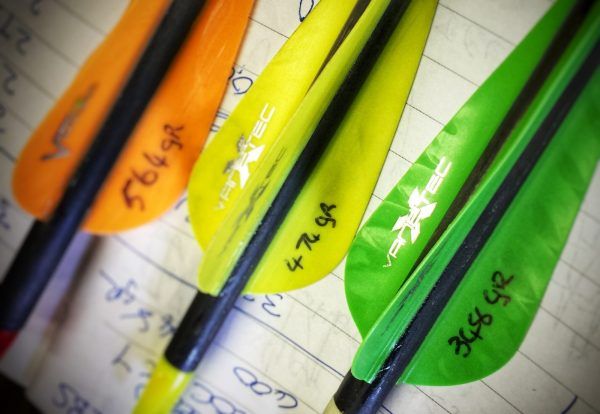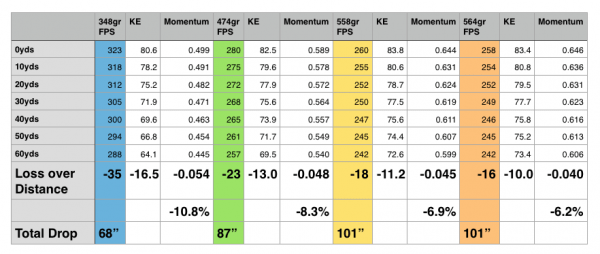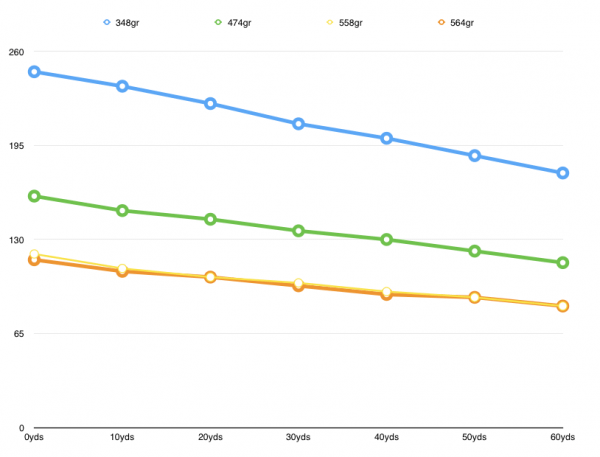
IBO, Kinetic Energy and Momentum
I recently read a comment from a seasoned veteran, about how Kinetic Energy is just marketing and doesn’t really mean anything… But I know it means a great deal, after all, along with IBO, it’s the only metric the factory can provide that closely resembles the average expected performance of the product. So this got me thinking…
Where is the disconnect?
My conclusion was that at a certain point in your archery career, you start taking things for granted, and you forget that there are important things to take into account because you just have a “gut knowledge” that something will work or not. Maybe just like the angler that knows to cast in a specific spot on a lake. Not for any reason that he can specifically explain, other than knowing that it feels right. And he usually is.
I think, though, it’s important to know all the parts that makes up a successful setup, and understand when things are important and how & why they fit together. So if I may take a moment of your time, I want to look at where these numbers come from and what they are useful for:
Here is the Short Version:
The advertised KE (Kinetic Energy) and IBO Speed refers to BOW’s POTENTIAL and gives you an ability to compare apples with apples.
Advertised IBO = 30” Draw Length, 70lbs speed comparison (…when possible – see below) – IBO is essentially the max speed.
Advertised KE = Maximum Energy possible from the bow on an IBO spec arrow (350gr) as far as possible – Think of KE as the size of the engine.
Once you have a bow, you can measure the speed from your choice of arrows and work out KE on the arrow and the Momentum of the arrow. From there you can find a sweet spot for your setup. The KE will be more or less constant (raising slowly as you make the arrow heavier) but speed will drop as momentum increases.
More speed = Flatter trajectory, but loses most speed and energy over distance
More Momentum = Better persistence of velocity and force, better penetration, but a faster drop rate – Think of momentum as the delivery vehicle…
So if you see a Bow is advertised with a KE in the 80’s and an IBO of 330+ There is very little that you cannot hunt with the bow. Only the very largest and toughest of animals will require some serious fiddling to get your setup into spec. The Engine is big enough to push to the maximum speed, the broadhead’s delivery vehicle: The Arrow.
However…
The fine print below will give you a better idea of how it all actually fits together because you may be able to get the Momentum or Kinetic energy that you want, but not be able to get close enough to an animal to deliver the arrow at enough speed to convert the Kinetic Energy into Penetration on the animal.
Kinetic Energy vs Momentum vs IBO speed
Starting with Kinetic Energy, you will run across the KE value in two places. The one is the KE in relation to the bow and the next is the KE in relation to the Arrow
For both, we calculate Kinetic Energy with the Arrow Weight (in grains) and the Speed of the Arrow (in feet per seconds) as follows:
(FPS x FPS x Weight of the Arrow) / 450,240 = Kinetic Energy of the Arrow

The KE of the Bow is the advertised Maximum Kinetic Energy you will achieve using an IBO arrow (350gr arrow or 5gr per lbs) – This is probably the least important value to pay attention to, but its not useless. It’s a clear indicator of what is possible.
Typically this value is measured at the maximum draw weight (usually 70lbs, but can be lower or higher) at the IBO draw length (30 inches, but varies from manufacturer to manufacturer. Some models will have a specific feature like a much heavier draw weight or much longer draw length which the manufacturer wants to highlight, in which case, that maximum may be used) That is why this value is simply an indicator, but it’s not a lie… Rather, it is a matter of whether your abilities can match the maximum abilities of the bow.
Something to note here is that a bow may seem low on KE or low on IBO speed, but might in fact not be the case. So before we look at the Kinetic Energy of the arrow, let’s look at the IBO speed.
The IBO speed is a more controlled comparison between bows, as it requires the speed calculation at the same specs for all bows: 70lbs at 30” draw length with a 350gr arrow.
As seen above, the IBO Speed would be calculated or measured, but it will be the base for the Kinetic Energy value of the bow… so it’s a critical component.
If you look at a bow like the Bowtech Carbon Rose, you will see that the KE (60.8 ft-lbs) as well as the IBO speed rating (302fps) is quite low. It hardly looks like a bow you should consider, but Bowtech, like other manufacturers, uses the maximum values the bow can perform at… in this case, 60lbs instead of 70lbs and a 27” draw length instead of 30” (that is why a long ATA bow like the BT-MagX has a KE of 97.9ft-lbs and 360fps – it’s a 34” maximum draw)

As you can see… if you did not know this important fact, you would never look at the Carbon Rose because it seems slow, but for 27” draw at 60lbs, it’s quite fast (calculated IBO is actually 332fps!)
But… why would you pay attention to these values? They are, after all, not real world values, only indicators… How your bow is set up (peep weights, speed weights, serving, string strand count, etc, etc) all makes a difference to what you will actually achieve.
Well, it means you can compare apples with apples before you buy, and especially if you have a shorter draw, it makes a big difference! It gives you an indicator of what you can expect from the bow…
So why not simply use Momentum as the indicator? The short answer? Momentum can not be estimated, it can only be calculated from a real world measurement…
 Once you have bought the bow, and set up with your arrow choice, you can measure your actual speed AND you can look at the Kinetic Energy of your arrow as a fair indicator of how much energy YOUR OWN SETUP can generate. How you transfer the energy from the bow to the arrow is now affected by the combined features of the loss of efficiency of the bow and string, the spine of the arrow, the FOC of the arrow and total weight of the arrow, etc, etc… All of those affect the performance of the arrow. Ignoring most of them, we simply look at the weight of the arrow and the speed generated by the energy of your bow and transferred to the arrow.
Once you have bought the bow, and set up with your arrow choice, you can measure your actual speed AND you can look at the Kinetic Energy of your arrow as a fair indicator of how much energy YOUR OWN SETUP can generate. How you transfer the energy from the bow to the arrow is now affected by the combined features of the loss of efficiency of the bow and string, the spine of the arrow, the FOC of the arrow and total weight of the arrow, etc, etc… All of those affect the performance of the arrow. Ignoring most of them, we simply look at the weight of the arrow and the speed generated by the energy of your bow and transferred to the arrow.
That becomes the Kinetic Energy of the arrow and from there you can calculate the actual Momentum of the arrow.
Why is the momentum of the arrow important?
The momentum of the arrow will actually tell you what kind of force the arrow is likely to impart during flight and what it’s persistence of motion will be. We calculate it as such:
Momentum(arrow) = (mass multiplied by velocity)/225400
for example:
(474gr arrow x 280fps ) / 225400 = 0,589 slug ft/sec
or
(564gr arrow x 258fps) / 225400 = 0.646 slug ft/sec
The higher the momentum value is, the better your arrow will carry it’s velocity over distance, and the more force it will impart on impact. Other benefits include less vibration on the shot and less noise (both of which steal energy out of the system) Which is also why the Slugs and KE both climb with weight of the arrow. The heavier the arrow, the slower it moves out of the bow and the more Kinetic Energy from the bow as a system is imparted during this extra time on the arrow. Which means less energy goes out as vibration and less as noise… (see, that one session in science class all those years ago was actually worth it!)
The negative, however, is that you will also end up with a slower moving arrow.
It is important to notice that there is a sweet spot. Beyond a certain point, all you are doing is to reduce the ability of system… and you will need to look at more than simple weight to increase the efficiency and ability of the arrow. This is where FOC (higher Front of Centre arrow builds) comes to their own.
 If you look at this chart of actual recorded Speeds at impact (Chronograph is 1yd in front of the target at distance) you will see that the light arrow (348gr) is really fast, and starts with a good KE, but only average Momentum. It also remains the biggest loser, except in it’s drop rate. At 60yds the total Drop is only 68 inches. Although, in total speed drop over distance, as well as KE and momentum, it loses the most and the fastest.
If you look at this chart of actual recorded Speeds at impact (Chronograph is 1yd in front of the target at distance) you will see that the light arrow (348gr) is really fast, and starts with a good KE, but only average Momentum. It also remains the biggest loser, except in it’s drop rate. At 60yds the total Drop is only 68 inches. Although, in total speed drop over distance, as well as KE and momentum, it loses the most and the fastest.
In comparison, the 348gr arrow will lose almost 11% of it’s Momentum at 60yds, where a heavier 564gr arrow only loses 6.2%
 Great, so the heavier the arrow, the better is the persistence? Yes, absolutely, a 564gr arrow will perform better on every level except two… speed starts to drop critically, and the drop rate of the arrow grows faster than you would care to control.
Great, so the heavier the arrow, the better is the persistence? Yes, absolutely, a 564gr arrow will perform better on every level except two… speed starts to drop critically, and the drop rate of the arrow grows faster than you would care to control.
The heavier 564gr arrow will drop 101 inches on 60yds, where the light 348gr arrow will only drop 68 inches.
So now the question simply becomes… for the typical animals you are expecting to hunt, at the typical distances you are expecting to hunt at, and if you have a passthrough most times at 0.589 Slug ft/sec (with a mid range a 474gr arrow), do you need to reduce your speed from 280fps to 258fps to get the maximum slugs (0.646 slug ft/sec on a 564gr arrow)?
Which brings us back to that mythical sweet spot, which, for me, an average adult male shooter I will most probably find between 500gr and 650gr.
All testing was done with my Bowtech BT-Mag at 29” draw and 67lbs draw weight on the comfort setting. (FYI, advertised 89.9KE and 340fps IBO)
The arrows were all GoldTip shafts with standard 3” VaneTech Fletches:
Goldtip Velocity Pro 400 at 348gr
GoldTip Kinetic 340 at 474gr
GoldTip Velocity 300 at 564gr
The last arrow was a similar GoldTip Velocity 300 but with the lighter and smaller VaneTech 2” HD vane, giving it an arrow weight of 558gr
Thank you to Archer’s Edge for providing the Range time and Chronographs to do this test. No matter how well you shoot, aiming at an expensive chronograph 60yds away becomes nerve wracking! (and why the data stops at 60yds instead of 80yds!) If you would like similar arrows built, please contact Archer’s Edge for expert advice and service!

